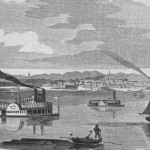One of the more ignominious chapters in Indiana history ended only in 1974, when the second piece of legislation permitting compulsory sterilization was repealed by the Indiana General Assembly. The origins of the long-standing law reach into the nineteenth century and have been linked with such enormities as the mass genocide perpetrated by Nazi Germany. Although its tenets had been discussed since the 1830s, the term “eugenics” was coined in 1883 by Francis Galton–a cousin of Charles Darwin–to suggest the betterment of the human race through social intervention. Scientists and physicians around the world gave credibility and support to the pseudo-scientific notion. In an article published in the New York Medical Journal in 1902, Dr. Harry Sharp glowingly described his experience providing vasectomies to the inmates in a Jeffersonville, Indiana reformatory. The three minute procedure–performed without anesthesia–not only improved his subjects’ physical and psychological constitution, in Sharp’s account. He argued that it also had the ultimately greater societal benefit of preventing the propagation of a criminal race. Acting outside the law, Sharp sterilized as many as 456 men at the institution from 1899 through 1907.
Sharp’s efforts were well received and supported by a growing number of doctors, agricultural breeders, sociologists, and public health officials in the Hoosier state. One of the nation’s most prominent eugenics theorists was David Starr Jordan, onetime president of Indiana University. “The pauper is the victim of heredity,” Jordan wrote in his 1902 publication Blood of a Nation, “but neither Nature nor Society recognizes that as an excuse for his existence.” Given the currency of eugenics in the collective mindset, and Harry Sharp’s extensive lobbying, the Indiana legislature passed a law on March 9, 1907, providing for the “prevention of the procreation of






















